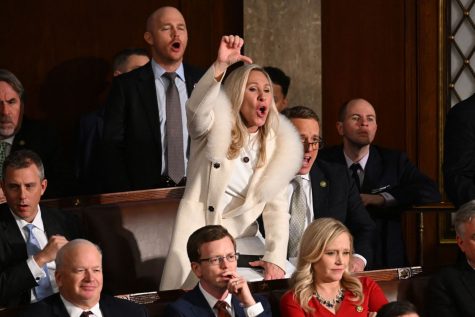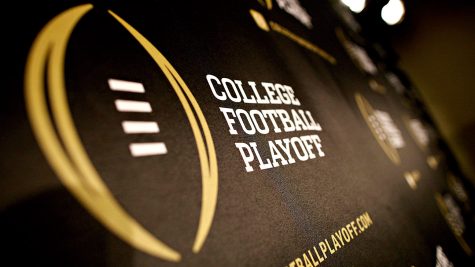EDITORIAL: District should abandon class rankings
Excessive amounts of homework, physically demanding sports and clubs, long hours of work, and countless nights without sleep are just some of the many conflicts that pervade the lives of academically advanced students. This is embodied no more clearly than in Olympic Heights salutatorian and National Merit Semifinalist Alison Granirer.
As someone actively partaking in AP/AICE courses and having eight dual enrollments (DE) under her belt, Granirer has faced the tremendous burden of maintaining both high grades and a job, in addition to engaging in extracurriculars such as the OH Hip-Hop Dance Team and the American Sign Language Club.
Unfortunately, that stress was too much to bear, and while she managed to obtain straight “A”s, pass all her exams, and receive academic recognition, it was not without physical and social consequences. “I put pressure on myself to always be at the top,” she admits. This desire to retain a high ranking induced so much competition that it interfered with her relationships amongst her fellow peers in the Top Ten. Not only that, Granirer also details that she developed the painful condition of stress ulcers, as her self-imposed anxieties took a dangerous toll on her own health.
This relentless pressure to maintain a high GPA is an ever-looming presence over the lives of high-school students in the Palm Beach County School District, who are integrated within a complex ranking system that encourages intense competition amongst its students.
The current ranking system distinguishes classes that are regular, honors, and college-level, and those at a higher level have a heavier weighting on a student’s cumulative weighted GPA (also known as HPA). Simply put, the more college-level classes and the better a student performs in them, the higher their ranking and HPA. This has led to the increased competition that many students are facing to get into the top-ranked colleges of the state, such as the University of Florida and the University of Miami, as well as prestigious Ivy League colleges throughout the country.
One might argue some competition is beneficial for growing adolescents – that it prepares them for the contentions of life in the workforce. However, at OH and throughout the nation, the academic recognition system in place is seemingly more disadvantageous than it is helpful when it comes to setting students onto their career paths.
Instead of encouraging teenagers to be exposed to a variety of career options and real-life skills through academies and classes such as art, culinary, early childhood, travel and tourism, drama, and chorus, high-achieving students are motivated to load their schedules with rigorous college-level courses.
OH Spanish teacher Ms. Margaret Sclafani is aware that some students at are engaging in these behaviors, explaining how “the beginning classes [of career-oriented academies and electives] are not honors level classes and students are afraid that their GPA/HPA will be affected.”
Journalism I is just one of the classes that suffers when hardworking, ambitious students are lost as they opt to dedicate their talents elsewhere. Even the higher level journalism courses such as the school newspaper or yearbook classes – which are honors level classes – are losing students to the courses that earn AICE or AP credit.
“With each passing year, we are losing more and more potentially very good writers who had an interest in being on the school newspaper staff but opted out once they were told they would only be receiving an honors credit rather than the higher-valued AP or AICE credit,” explains Mr. David Keithley, OH’s faculty adviser to the student newspaper, The Torch. “It’s sad that those students are opting out of courses which may be more to their interest and liking in order to chase a minimal class ranking boost by taking courses less attractive to them. I feel it’s detrimental to their overall high school experience.”
Even Aryeh Silver, who is ranked third in the senior class, believes rank to be a “bad way to measure academic achievement” since it counts “what activities you are willing to sacrifice in order to take more AP/AICE/dual enrollment classes” and thus discredits “many classes, such as band, that… allow you to learn a lot and gain valuable skills.”
Many students fear that a lower HPA will lessen their chance of being accepted into their dream schools. For example, current Ms. OH and National Honor Society Co-President Shoshana Halperin admits, “Everything I did in high school was based on college acceptance.” She reveals that she is taking AP Environmental Science this year not because she is interested in the subject, but because she was told that in order to be competitive for a college she needed to take four years of science. An AP science class would kill two birds with one stone, as it would boost her ranking at the same time.
One of the problems stemming from the ranking system is not so much the enrollment of AP and AICE classes, but rather the sheer number of students who are dual enrolled simultaneously. An OH semester schedule is limited by a maximum of seven classes. But with the growing popularity of dual enrollment in recent years, students are deciding to take dual enrollment courses during the school year and over the summer, either in addition to their seven classes or in some cases as a substitute for AP/AICE classes at school.
With a 5.3836 weighted GPA, senior valedictorian Max Wyatt has not only achieved straight “A”s in all his classes, but has also taken 12 dual enrollment courses. The exorbitant number of classes that he felt obligated to undertake depicts the competitive atmosphere that demands such intensive time and energy commitment from developing young adults. Wyatt discloses, “I have taken the majority of my DE classes in order to boost my HPA, but some classes like Business Law 1 and 2 I selected as prerequisites for my future major in college.” While dual enrollment effectively ensured Wyatt’s title of valedictorian, his many hard-earned college credits may not even end up being applied toward college since schools cap the number of credits that incoming freshmen are able to transfer.
The obsession with dual enrollment is becoming increasingly evident in the underclassmen, with juniors now feeling the tension. Having already taken four dual enrollments over the last two summers, junior Kasey Michaud is currently ranked fifth in his graduating class. He has experienced the heightened pressure from his family, guidance, and other students around him.
“The first time I took DE, it was because my mom wanted me to,” Michaud explains. “The second time around, I realized the benefits. Maybe it would cushion the blow when all these people take seven AP classes next year, while I’m only taking four. And it did, my rank is fine.” Michaud also feels that each graduating class is getting more competitive than the last, pointing out that many sophomores are already acting like seniors when it comes to their course load and stress regarding rank.
In this respect, the ranking system can be compared almost to a game of chess in which students are players who must outsmart the others around them in terms of course selection. Silver recognizes the “game,” admitting that “you must know its ins and outs from a very early stage, or else you’re at a big disadvantage. Basically, to have a high rank, you must begin dual enrolling extremely early.”
According to Psychology Today, “What is rewarded by singling out those with the best grades isn’t always merit or effort but some combination of skill at playing the game of school (choosing courses with a keen eye to the effect on one’s GPA, figuring out how to impress teachers, etc.) and a willingness to sacrifice sleep, health, friends, reading for pleasure, and anything else that might interfere with one’s grades.” Economics and Government teacher Mr. Carlos Ramon agrees that the successful class rank chasers “are able to multitask and overload themselves throughout a four year period.”
This “game” is even more apparent when some students decide to substitute AP/AICE classes offered at OH with dual enrollment and online courses of equal value. Although guidance makes an effort to curtail this scheme, it is still evident here at OH. Olympians Advanced Placement Academy (OAPA) coordinator Ms. Kelly Lawrence maintains that she is “pretty adamant about not allowing [students] to replace” such classes unless it’s “an effort to accelerate” and free up their schedule the following year.
This is demonstrated in the substantial number of students who dropped out or decided not to enroll in Ramon’s AP Microeconomics course, which is considered to be one of the hardest senior classes to earn an A in. Last semester, approximately 20 students dropped out of the AP Microeconomics class within the first few weeks, leaving only around 40 students who followed through.
Notably, just four of the Top Ten students took this course at school. According to Lawrence, both she and college admissions officers are aware that AP/AICE courses tend to be more challenging than DE, as “they have required course outlines they must follow, whereas one dual enrollment professor might be really rigorous and another one might be easy-peasy. And we all know that many kids in their pursuit of DE courses look for easy professors.”
Essentially, students are afraid that they might get a B or C in the AP class and therefore choose easier alternatives with the same GPA boost that they feel confident they will receive an A in. Considering that an economics course is a graduation requirement and AP Microeconomics is the only AP Economics class offered on campus, the lack of students enrolling in the course provides insight into how teens are “playing” this obviously flawed system to their advantage in terms of competition and ranking.
There is also a point to be made about the ranking system putting students who do not possess the transportation means to and from a college at a disadvantage. Of course, online dual enrollment is an alternative, but junior Alexis Whitt remarks that some students just don’t succeed in an online class environment. “Some people aren’t good test-takers and are just unable to have transportation to dual enroll,” she adds. “I don’t think that should determine students’ GPA or ability to get into college.”
Our opinion at The Torch is that the ranking system simply should not exist. But seeing as that goal is a long way off, we believe that the best way to amend the system is to count dual enrollment as college credit but not factor it into HPA. Additionally, a widely echoed opinion is that students should not be able to evade a difficult AP/AICE course offered at school. Ramon elaborates, “If a course is being provided here, I don’t think students should have the option of dual enrolling or taking a Florida Virtual School alternative.” Even Lawrence and guidance counselor Ms. Natalie Lima firmly disavow the ranking system, with Lima calling it “a competition that doesn’t need to be had” and Lawrence emphasizing that it “fosters ugliness among peers.”
Unfortunately, ranking leaves several high-achieving and hardworking students feeling underrecognized. National Merit Semifinalist and Hispanic Scholar Alyson Garcia is an example of a student who has maintained straight “A”s her entire high school career, with a 5.0085 weighted GPA. She has taken a total of 13 AP/AICE classes with one dual enrollment course and passed all exams in each. Yet, Garcia is not in the coveted Top Ten of her graduating class, instead placing twentieth. While she does not place much value on rank and has focused her energies on pursuing classes that speak to her interests, she does express her frustration that “it’s so dependent on dual enrollment, it’s not even about high school classes anymore. It’s about going out of your way to get college credits.”
There is such a razor thin margin separating the best students that it is absolutely silly to assign them numbers to rank their academic achievement. Consider the very fine line between the GPAs of the top twenty students: a 0.3751 difference separates the valedictorian and Garcia. Add that to the fact that rank is ultimately irrelevant when it comes to college acceptances. “Time and time again” Lima explains to students that “rank does not matter” to college admissions officers.
Lawrence believes our community experiences “a complete inability to understand the difference between performance and GPA.” When a student tells her that he/she wants to take a class to raise their GPA she responds, “Number one, [colleges] are going to throw that class out when they recalculate your GPA. Number two, all they care about is your class rigor, your performance (meaning grades) in said classes, and your scores first. Once you tick those boxes, they look at everything else.”
So why do we unnecessarily torture ourselves with demanding schedules? The answer is simple: to compete with our peers. For instance, Halperin not only took 14 AP/AICE classes, but nine dual enrollments, voicing how she “wouldn’t have done dual enrollment without the competition between the classmates [she] had.” Instead of basking in the rich architectural beauty and historical landscape while visiting Spain, Halperin “wasted [her] summer” while in Barcelona doing online dual enrollment classes. She was extremely frustrated to have her effort and time commitment seemingly not pay off, as she ended up being ranked 28 when she clearly was aiming higher.
The newly implemented SIS (Student Information Systems) only fuels this obsessive rivalry by providing constant, immediate feedback on grades and ranking that both students and families can acquire anytime, anywhere with a simple click.
While a high school experience without rank might seem unimaginable to those of us in Palm Beach County, it is certainly a reality in many areas around the country and especially the world. Lexi Rosenberg, a current college freshman at the selective SUNY Binghamton, attended a New York high school that did not rank. She believes that the lack of ranking made her feel less competitive in terms of GPA and keeping up with classmates because “we only had to compete against ourselves so it made me work harder to be better for colleges and myself.”
OH English treacher Mr. Michael Taylor grew up in England and was accustomed to a very different norm. He illustrates, “We were never awarded a drip feed of grades, we just did work and tried to improve until the end of the year when we would take exams based on everything we learned… which were all we used to move through the education system when we graduated at sixteen.”
A possible solution for our school district could be to follow neighboring Miami-Dade’s lead. Miami-Dade County schools eliminated the designations of valedictorian and salutatorian with the class of 2008 and instead put a system in place to honor a greater range of students. Now, students that graduate in the top five percent of their class receive summa cum laude honors, top 10 percent receive magna cum laude, and top 15 percent or anyone with a 4.0+ GPA receive cum laude. This laude system is widely used by universities, and thus appears to be more fair as well as a better preparation for life after high school.
As Michaud declares, “The ranking system rewards students who work smarter, not harder.” Our current system is instilling the wrong values in teenagers. The main takeaway from high school should not be to blindly follow suit and choose the easy route, but rather to travel the unbeaten path that leads to life-long learning and success.
















Chris M • Mar 3, 2020 at 3:51 pm
A well thought essay that comes to grips with a process most staff readily admits has flaws, but one parents and students seem committed to keep- or maybe not so much any more. A fresh perspective from outside the staff room.